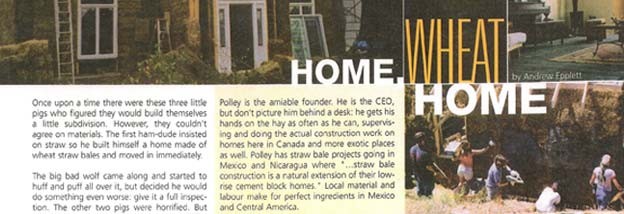House of straw environmentally friendly – Guelph Mercury
By Peter Cowan
Special to the Mercury
Hillsburgh
When Ben Polley designed and ecologically friendly straw bale home, his first priority was to make the house livable.
“For comfort this acts like any conventional home”, said Polley, whose company, Harvest Homes, builds straw bale houses.
“He wanted to create a house that didn’t require a different lifestyle but was still environmentally friendly, more energy efficient and safer for people.
“This isn’t the house of the future, this is the house of right now,” he said.
At the end of the month, Polley will move in as the firs tenant of Home Alive!, the 1,200-square-foot demonstration home built at Everdale, the Environmental Learning Centre near Hillsburgh.
Today from 10 a.m. To 4 p.m. Is the pubic opening for the house, with an official opening ceremony at 1:30 pm.
The demonstration home will be open every Saturday after that, from 10 am to 4 pm.
The idea is to showcase different ecological building techniques.
The Straw bale frame for the house was originally constructed in a warehouse in Guelph and then reassembled for the National Home Show last year in Toronto.l
At the end of the show it was taken apart again and reassembled at the learning centre.
More than 250 volunteers helped assemble and finish the house.
The straw bale construction is three times more energy efficient and ten times stronger than traditional dry-wall said Polley. It is also essentially fireproof.
The straw bales are put together like bricks and then plastered over to give a smooth finish similar to drywall on the inside.
And even with all of its advantages, bale construction doesn’t cost any more than traditional building techniques, Polley said.
Almost everything in the house is donated by one of 100 suppliers who helped in the project.
Jane Holmsen from the US-based Marven Windows visited the home yesterday to see the fibreglass windows donated by her company.
She said traditional vinyl windows are a huge source of pollution, but telling people about the alternatives is difficult.
“It’s a story that is hard to get out.” she said. She hopes the demonstration house will get more people exposed to some of the alternative products available.
It is not just home buyers the demonstration house is aimed at. Polley said it is especially important to make sure contractors know about the options available.
Builders use the materials they are most familiar with and it is important to l et them know what more environmentally friendly alternatives are available.
Wally Seccombe, chair of the board at the Everdale centre, said he was amazed by the response from builders at the home show. One builder came up and told him that after 20 years in the industry, he had no idea that alternatives exist.
Bamboo flooring is an example of an environmentally friendly alternative that costs the same as hardwood, which is traditionally used.
The flooring is used in the upper floor of the house and looks very similar to hardwood.
Polley said bamboo is a lot more environmentally friendly because it grows back very quickly and can be harvested every three or four years.
Maple, which costs the same as bamboo flooring, takes more than 10 times longer to grow back.
Polley said many people don’t know about the bamboo because it has only recently become economical, so there aren’t as many suppliers.
As well as showing the home, Polley will offer courses at the learning centre to teach straw bale construction techniques to other builders.
He said with the huge demand for the straw bale houses, his company can’t keep up. Later this year he also hopes to have a store on-site where the public and contractors can buy products used in the house.
Polley isn’t counting on everyone who visits the home to totally revamp their own house. He just wants them to take on idea or two back with them.
“I hope everyone will find at least one thing they could imagine including themselves.

